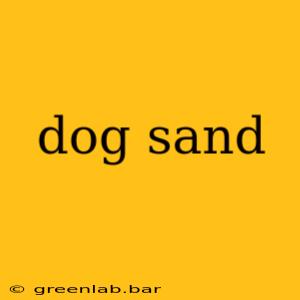For dog owners, maintaining a clean and comfortable environment for their furry friends is paramount. This often involves dealing with the inevitable mess – mud, dirt, and, yes, even sand! This comprehensive guide explores the multifaceted world of "dog sand," covering everything from understanding the various types of sand your dog might encounter to effective cleaning strategies and preventative measures.
Understanding the Challenges of Dog Sand
Sand, unlike mud, presents a unique set of challenges. Its fine particles are easily embedded in your dog's fur, clinging stubbornly and finding their way into every nook and cranny of your home. This isn't just an aesthetic issue; sand can irritate your dog's skin, causing discomfort and even potential infections if not properly removed. Furthermore, tracked-in sand can scratch floors, damage furniture, and generally create a messy home environment.
Types of Sand Encounters:
- Beach Sand: This is the most common culprit, often coarse and gritty. Its larger particles can be more easily removed, but it still requires thorough cleaning.
- Construction Sand: Finer and potentially more abrasive than beach sand, construction sand poses a greater risk of skin irritation and requires extra care during removal.
- Play Sand: Found in parks and playgrounds, this sand is generally finer and can be difficult to remove completely.
Effective Cleaning Strategies for Sand-Covered Dogs
Removing sand from your dog's coat requires a multi-pronged approach:
1. Pre-Cleaning: The Outdoor Shake-Down
Before bringing your sandy canine indoors, give them a good shake-out outside. This initial step removes a significant amount of loose sand, minimizing the mess inside.
2. Brushing: The Essential First Step
Thorough brushing is crucial. Use a slicker brush, undercoat rake, or even a de-shedding tool, depending on your dog's coat type. Pay close attention to areas where sand tends to accumulate, such as the paws, legs, and belly. For stubborn sand, consider using a specialized deshedding tool designed for removing embedded debris.
3. Bathing: When Brushing Isn't Enough
For heavily soiled dogs, a bath is necessary. Use a mild dog shampoo and lukewarm water. Pay extra attention to rinsing thoroughly to remove all traces of sand and shampoo residue, preventing skin irritation. A final rinse with cool water helps close the hair cuticle, leaving the coat smoother and shinier.
4. Drying: Towel Dry and Air Dry
After bathing, towel dry your dog as much as possible. Allowing them to air dry completely helps prevent further skin irritation.
Preventing Sand Buildup: Proactive Measures
Prevention is always better than cure. Here are some strategies to minimize sand exposure:
- Paw Cleaning: Keep a designated towel or mat near entrances to wipe your dog's paws after outdoor excursions. Consider using a paw cleaner designed specifically for removing dirt and debris.
- Regular Grooming: Regular brushing helps prevent sand from becoming deeply embedded in your dog's coat.
- Controlled Play Areas: If possible, restrict your dog's access to sandy areas, particularly if they have sensitive skin.
Conclusion: Keeping Your Dog Sand-Free
Dealing with sand-covered dogs requires consistent effort and the right approach. By understanding the challenges sand presents, employing effective cleaning strategies, and implementing preventative measures, you can keep your canine companion clean, comfortable, and happy, minimizing the sand's impact on your home and your dog's well-being. Remember, consistent grooming and a proactive approach will make the whole process far less daunting.

